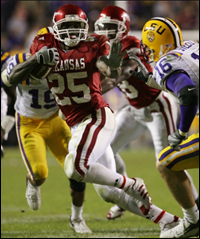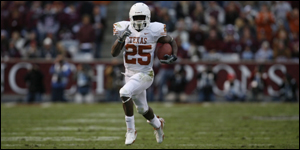|
National Football League
Draft King Analysis
December 17, 2007
Lou Pickney, DraftKing.com
Reader feedback is always welcomed here at DraftKing.com. Send your thoughts to me at LouPickney@gmail.com.
There are at least 15-20 junior running backs who could opt for early entry into the NFL Draft. It's not always a good idea for guys to do that (e.g. Darius Walker leaving Notre Dame early and going undrafted), but it can and will happen. And while not all of the big names will come out, those who do will likely have a major impact on the draft. Listed below are eight potential day one picks who are junior RBs; next to each name is the listed height, weight, and estimated 40 yard dash time.
1. Darren McFadden, RB, Arkansas (6'2", 210, 4.40-4.45)
If there's any junior who should come out, it's McFadden. He finished second in the Heisman voting two straight years. His coach bolted for Ole Miss. He is an electrifying athlete who has a strong mix of speed, stamina, strength, fundamentals (as I detailed here), and swagger.
Barring an injury in the Cotton Bowl, McFadden should be the first running back taken in the 2008 NFL Draft, and he could easily be a top five selection, possibly as high as #2 depending on how the draft order falls into place. There will be plenty more to write about McFadden between now and April, but the bottom line is that he should be a dominant NFL player from day one.
2. Jonathan Stewart, RB, Oregon (5'11", 235, 4.40-4.55)
Stewart is an anomaly at running back, a 235 pound beast whose clocked speed has fluctuated but who is skilled enough to be used as a kick return on an Oregon team that is not using him out of need (they have other fast players on the team.) And, even after Oregon's QB Dennis Dixon suffered a season-ending knee injury, Stewart managed to perform admirably.
Stewart suffered a sprained ankle against Arizona, but he managed to play through the pain and ended the regular season with a 39 carry, 164 rushing yard performance against in-state rival Oregon State. Stewart has shown that not only is he a physical runner, he can also overcome pain, which is vital for anyone in the NFL, let alone a running back who takes plenty of hits.
Stewart's height is about average for a running back, and assuming that his bulk allows him to perform well in blocking and picking up the blitz in pass protection, he could be a breakout star in the NFL next year.
|  | Arkansas RB Felix Jones doesn't shy away from contact on the field. (Thomas B. Shea/Icon SMI)
|
3. Rashard Mendenhall, RB, Illinois (5'11", 210, 4.45-4.50)
This isn't a locked-in order of expected draft position by any means, particularly so far out from April, and Mendenhall is a player on the rise who is also strongly hinting that he'll be leaving Illinois for the NFL after the Rose Bowl. Mendenhall will face a stiff test in USC's defense, and his performance on the big stage in USC's hometown may have an impact (pro or con) on his draft plans.
4. Felix Jones, RB, Arkansas (6'0", 200, 4.35-4.45)
Jones is perhaps the most likely of the top four junior RBs to return to school. I consider it too close to call among Stewart, Mendenhall, and Jones for the #2-4 spots, but for now Jones is here. But make no mistake: Jones is NFL ready and has elite skills. The presence of Darren McFadden on the Arkansas roster allowed Jones to be overlooked by fans and media alike, but Jones brings an added dimension to the competition with his strong kick return skills. He may not be able to post Roscoe Parrish punt return numbers, but still he is a two-in-one threat thanks to his consistently strong kick return skills to go with his ability to be a feature back.
Consider this: even with Darren McFadden in the same backfield (and H-back Peyton Hillis also taking away carries), Jones posted 1,100+ rushing yards in 2006 and 2007. He has prototype RB size, great speed, and should be a first round pick if he opts to make himself eligible for the 2008 NFL Draft.
5. Ray Rice, RB, Rutgers (5'9", 195, 4.45-4.55)
With the exception of an early season blowout win over Norfolk State (where he was used sparingly), Rice posted 100+ yards rushing in every game this year. He is a determined runner who is skilled at finding the hole, hitting it with acceleration, and taking off into the open field.
What causes the drop from the top four junior RBs to the likes of Ray Rice and Steve Slaton is size. There are some small running backs who are in the midst of solid NFL careers (e.g. Warrick Dunn and Maurice Jones-Drew), and while Rice isn't tiny, that slight 2-4 inch difference in height compared with the big boys will likely be enough to keep him from cracking that top tier.
Rutgers coach Greg Schiano will be back next year, which would seem to give Rice an edge toward staying versus the likes of the Arkansas RB duo and Steve Slaton. But Rutgers has been running Rice into the ground (as previously noted on here), and for his long-term health and ability to have a lengthy career on the NFL level, another year of taking a pounding might be a deterrent.
At it is, Rice has gone on record saying that Schiano's return would not be a factor in what he decides to do, and if the NFL College Advisory Committee indicates that Rice is a possible first round pick, he may go ahead and head into the pros.
6. Steve Slaton, RB, West Virginia (5'10", 195, 4.35-4.45)
It may be unfair to classify Slaton as a small running back; perhaps "lanky" is a more accurate assessment of his physical stature. If he can add 10-15 pounds of muscle in the next couple of months without hurting his elite speed, he could make a late run up NFL draft boards. Or he could stick at WVU for one more shot at the elusive BCS Title, but with Rich Rodriguez leaving for the NFL, I would think that Slaton would now be more inclined to make his move now to the NFL.
|  | Texas RB Jamaal Charles has good agility and breakaway speed. (Aaron M. Sprecher/Icon SMI)
|
7. Jamaal Charles, RB, Texas (6'1", 200, 4.35-4.40)
Charles lead the Big 12 in 2007 with 1,458 rushing yards and 16 TDs. He has wonderful size, good instincts, and he possesses that "extra gear" that can allow him to break long touchdown runs. Charles, who's also on the track team at the University of Texas, has filed paperwork with the NFL College Advisory Committee. To date, only one player during the Mack Brown extra at Texas has left school early for the NFL (Vince Young in 2006), and it's entirely possible that Brown will be able to coax Charles back to school.
Last month, the Houston Chronicle reported in a blog section that Charles would be returning for his senior year. But that same report also indicated that Charles wouldn't put his name in with the NFL College Advisory Committee, so at this point all bets are off.
The presence of a talent like Charles, who could potentially be on the board in round two, in the 2008 Draft could have a paradoxical effect on the selection of running backs in the first round. That is particularly true if a team thinks that it can obtain a high-quality running back in Charles without having to cough up first round cash to get him.
The draft is not typically looked at as a pure supply-and-demand situation, but there will clearly be more importance placed on running back talent if there are only 4-5 high-end RBs in the mix versus 8-9.
While Charles is placed at #7 on this list, with his ability he could easily end up at #2; there's little separation between many of the elite junior RBs at this point. I imagine that Charles will come back to Texas, but if he doesn't, he could be a major sleeper pick in April's 2008 NFL Draft.
8. Kevin Smith, RB, UCF (6'1", 210, 4.45-4.55)
Of the eight players profiled on this page, Smith would seem at this point to be the least likely to come out early for the NFL Draft. According to this article in the Orlando Sentinel, Smith, who turned 21 today, plans to officially announce tomorrow that he intends to return to the University of Central Florida for his senior season.
To be clear, Smith would still have until January 15, 2008 to change his mind. Smith has a shot at becoming the NCAA I-A (FBS) single-season rushing leader, should he be able to post 181 or more rushing yards against Mississippi State in the Liberty Bowl on December 29. Barry Sanders set the record in 1988, but the season record is a skewed stat since Sanders did it in only 11 games, and the records don't reflect Sanders' memorable 225 yard performance in the 1988 Holiday Bowl. That's because, prior to 2002, bowl game performances did not count toward regular season records. But, any way you slice it, Smith has had a great year.
There is the chance that Smith might be in danger of wearing himself down too much by going through another season of college ball, similar to what Ray Rice faces at Rutgers, but at this point it appears that Smith will be coming back to school. We'll see if he changes his tune after the Liberty Bowl.
NFL Draft Prospect Profiles
Draft King is owned and operated by Lou Pickney. Copyright © 2003-2026, all rights reserved. Information on this website should not be used for any gambling purposes, nor does it constitute any sort of advice, financial or otherwise.
|

